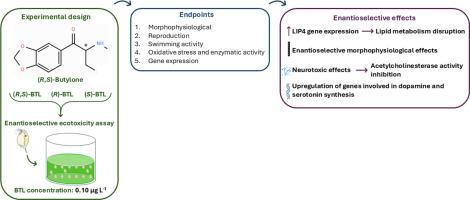Unveiling enantioselective mechanisms of toxicity of butylone in Daphnia magna
IF 4.3
2区 环境科学与生态学
Q1 MARINE & FRESHWATER BIOLOGY
引用次数: 0
Abstract
Butylone (BTL) is a chiral synthetic cathinone widely abused due to its stimulant and hallucinogenic effects. It is available as a racemate and reported as a contaminant in wastewater. Our previous studies revealed BTL toxicity and of its enantiomers to non-target species. Nevertheless, the mechanisms underlying its toxicity remain poorly understood, particularly after sub-chronic exposure. This study aimed to expand the understanding of the ecotoxicity of BTL and its enantiomers by studying the potential mechanisms of toxicity after 15 days of exposure using Daphnia magna freshwater model. For that, neonates (<24 h) were exposed to an environmentally relevant concentration (0.10 μg L−1) of the racemate (R,S)-BTL or each pure enantiomers, (R)-BTL or (S)-BTL, to study various key endpoints (morphophysiological, biochemical, reproductive, swimming activity, and gene expression). Results showed that both racemate and (S)-BTL exposure significantly induced triacylglycerol lipase (LIP4) gene expression linked to lipid metabolism, negatively affecting the growth and body size of the specimens exposed. Moreover, neurotoxicity was evidenced by the inhibitory response on acetylcholinesterase activity (AChE) and the upregulation of the expression of genes involved in the synthesis of dopamine and serotonin. Yet, swimming activity, reproduction and survival of D. magna remained unaffected. Enantioselective effects were observed in body growth (decrease (S)-BTL and increase (R)-BTL), heart size and area (increase (R)-BTL), and aromatic l-amino acid decarboxylase (AAAD) transcription levels (all BTL forms). Overall, the findings highlighted that environmentally relevant concentrations of BTL can lead to adverse effects in D. magna, confirming the potential threat of this illicit drug to this freshwater invertebrate, and can impact the primary consumers and aquatic food webs and their ecosystems.

揭示丁酮对大水蚤毒性的对映选择机制。
丁酮(BTL)是一种手性合成卡西酮,因其具有兴奋和致幻作用而被广泛滥用。它是一种外消旋物,据报道是废水中的污染物。我们之前的研究揭示了BTL及其对非靶物种的毒性。然而,其毒性机制仍然知之甚少,特别是在亚慢性暴露后。本研究采用大水蚤(Daphnia magna freshwater model)模型研究BTL及其对映体暴露15 d后的潜在毒性机制,旨在扩大对BTL及其对映体生态毒性的认识。为此,对外消旋体(R,S)-BTL或各纯对映体(R)-BTL或(S)-BTL的新生儿(-1)进行研究,以研究各种关键终点(形态生理、生化、生殖、游泳活动和基因表达)。结果表明,外消旋体和(S)-BTL暴露均显著诱导与脂质代谢相关的三酰基甘油脂肪酶(LIP4)基因表达,对暴露样品的生长和体型产生负面影响。此外,对乙酰胆碱酯酶活性(AChE)的抑制反应以及参与多巴胺和血清素合成的基因表达的上调证明了神经毒性。然而,游泳活动、繁殖和存活均未受影响。在体生长(减少(S)-BTL和增加(R)-BTL)、心脏大小和面积(增加(R)-BTL)和芳香l-氨基酸脱羧酶(AAAD)转录水平(所有BTL形式)中均观察到对映选择效应。总体而言,研究结果强调,与环境相关的BTL浓度可导致D. magna的不利影响,证实了这种非法药物对这种淡水无脊椎动物的潜在威胁,并可能影响主要消费者和水生食物网及其生态系统。
本文章由计算机程序翻译,如有差异,请以英文原文为准。
求助全文
约1分钟内获得全文
求助全文
来源期刊

Aquatic Toxicology
环境科学-毒理学
CiteScore
7.10
自引率
4.40%
发文量
250
审稿时长
56 days
期刊介绍:
Aquatic Toxicology publishes significant contributions that increase the understanding of the impact of harmful substances (including natural and synthetic chemicals) on aquatic organisms and ecosystems.
Aquatic Toxicology considers both laboratory and field studies with a focus on marine/ freshwater environments. We strive to attract high quality original scientific papers, critical reviews and expert opinion papers in the following areas: Effects of harmful substances on molecular, cellular, sub-organismal, organismal, population, community, and ecosystem level; Toxic Mechanisms; Genetic disturbances, transgenerational effects, behavioral and adaptive responses; Impacts of harmful substances on structure, function of and services provided by aquatic ecosystems; Mixture toxicity assessment; Statistical approaches to predict exposure to and hazards of contaminants
The journal also considers manuscripts in other areas, such as the development of innovative concepts, approaches, and methodologies, which promote the wider application of toxicological datasets to the protection of aquatic environments and inform ecological risk assessments and decision making by relevant authorities.
 求助内容:
求助内容: 应助结果提醒方式:
应助结果提醒方式:


